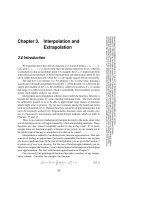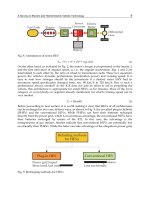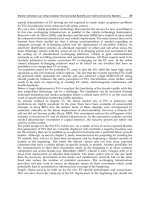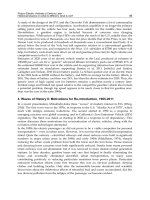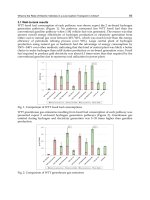Electric Vehicles The Benefits and Barriers Part 1 pptx
Bạn đang xem bản rút gọn của tài liệu. Xem và tải ngay bản đầy đủ của tài liệu tại đây (625.47 KB, 20 trang )
ELECTRIC VEHICLES – THE
BENEFITS AND BARRIERS
Edited by Seref Soylu
Electric Vehicles – The Benefits and Barriers
Edited by Seref Soylu
Published by InTech
Janeza Trdine 9, 51000 Rijeka, Croatia
Copyright © 2011 InTech
All chapters are Open Access articles distributed under the Creative Commons
Non Commercial Share Alike Attribution 3.0 license, which permits to copy,
distribute, transmit, and adapt the work in any medium, so long as the original
work is properly cited. After this work has been published by InTech, authors
have the right to republish it, in whole or part, in any publication of which they
are the author, and to make other personal use of the work. Any republication,
referencing or personal use of the work must explicitly identify the original source.
Statements and opinions expressed in the chapters are these of the individual contributors
and not necessarily those of the editors or publisher. No responsibility is accepted
for the accuracy of information contained in the published articles. The publisher
assumes no responsibility for any damage or injury to persons or property arising out
of the use of any materials, instructions, methods or ideas contained in the book.
Publishing Process Manager Ivana Lorkovic
Technical Editor Teodora Smiljanic
Cover Designer Jan Hyrat
Image Copyright Alila Sao Mai, 2010. Used under license from Shutterstock.com
First published August, 2011
Printed in Croatia
A free online edition of this book is available at www.intechopen.com
Additional hard copies can be obtained from
Electric Vehicles – The Benefits and Barriers, Edited by Seref Soylu
p. cm.
ISBN 978-953-307-287-6
free online editions of InTech
Books and Journals can be found at
www.intechopen.com
Contents
Preface IX
Chapter 1 A Survey on Electric and Hybrid
Electric Vehicle Technology 1
Samuel E. de Lucena
Chapter 2 Electric Vehicles in an Urban Context:
Environmental Benefits and
Techno-Economic Barriers 19
Adolfo Perujo, Christian Thiel and Françoise Nemry
Chapter 3 Plug-in Electric Vehicles
a Century Later – Historical lessons
on what is different, what is not? 35
D. J. Santini
Chapter 4 What is the Role of Electric Vehicles
in a Low Carbon Transport in China? 63
Jing Yang, Wei Shen and Aling Zhang
Chapter 5 Plug-in Hybrid Vehicles 73
Vít Bršlica
Chapter 6 Fuel Cell Hybrid Electric Vehicles 93
Nicola Briguglio, Laura Andaloro,
Marco Ferraro and Vincenzo Antonucci
Chapter 7 Supercapacitors as a Power
Source in Electrical Vehicles 119
Zoran Stević and Mirjana Rajčić-Vujasinović
Chapter 8 Integration of Electric Vehicles
in the Electric Utility Systems 135
Cristina Camus, Jorge Esteves and Tiago Farias
VI Contents
Chapter 9 Communication with and for Electric Vehicles 159
Jonas Fluhr and Theo Lutz
Chapter 10 Applications of SR Drive
Systems on Electric Vehicles 173
Wang Yan, Yin Tianming and Yin Haochun
Chapter 11 LiFePO
4
Cathode Material 199
Borong Wu, Yonghuan Ren and Ning Li
Chapter 12 An Integrated Electric Vehicle Curriculum 217
Francisco J. Perez-Pinal
Preface
Internal combustion engines have experienced an enjoyed monopoly for almost a
century as power sources of road transport vehicles. But, in the same period, vehicle
ownership and mileages increased to a level that the resulting petroleum based fuel
consumption, urban air pollutants and green house gas emissions (the challenging
triad) have became great concern especially for past a few decades. There have been
several regulations issued to be remedy for the challenging triad, but even in the most
developed countries, the challenging triad has been still one of the biggest threats for
sustainable transport and development of urban agglomerations.
Development in internal combustion engines and their fuels was very fast in the early
decades of the 20
th
century, but today internal combustion engines are at their mature
levels that any further development to increase engine efficiency and minimize the
emissions is expected to be very little if ever possible. Any improvement in engine
and fuel technology for better efficiency and emissions either increases the cost to
uncompetitive levels or brings additional environmental problems when especially
considering life cycle of the engines and fuels.
Electric vehicles, on the other hand, are becoming promising alternatives to be remedy
for the challenging triad and sustainable transport as they use centrally generated
electricity as a power source. It is well known that power generation at centralized
plant is much more efficient and its emissions can be controlled much easier than
those emitted from internal combustion engines that scattered all over the world.
Additionally, an electric vehicle can convert the vehicle’s kinetic energy to electrical
energy and store it during braking and coasting.
All these benefits of electrical vehicles are starting to justify, a century later, attention
of industry, academia and policy makers again as promising alternatives for urban
transport. Nowadays, industry and academia are striving to overcome the challenging
barriers that block widespread use of electric vehicles. Lifetime, energy density and
power density, weight, cost of battery packs are major barriers to overcome. In this
sense there is growing demand for knowledge to overcome the barriers and optimize
the components and energy management system of electrical vehicles.
X Preface
In this book, theoretical basis and design guidelines for electric vehicles have been
emphasized chapter by chapter with valuable contribution of many researchers who
work on both technical and regulatory sides of the field. Multidisciplinary research
results from electrical engineering, chemical engineering and mechanical engineering
were examined and merged together to make this book a guide for industry, academia
and policy maker.
To be effective chapters of the book were designed in a logical order. It started with
the examination of historical development of electrical vehicles. Then, an overview of
the electrical vehicle technology with the benefits and barriers was presented. After
that current state of the art technology and promising alternatives for electrical vehicle
components were examined. Finally, to establish the required knowledge for
overcoming the major barriers electrical vehicles, the state of the art curriculum from
technician to PhD education was introduced.
As the editor of this book, I would like to express my gratitude to the chapter authors
for submitting such a valuable works that already published or presented in
prestigious journals and conferences. I hope you will get maximum benefit from this
book to take the urban transport system to a sustainable level.
Seref Soylu, PhD
Sakarya University
Department of Environmental Engineering, Sakarya,
Turkey
1
A Survey on Electric and Hybrid
Electric Vehicle Technology
Samuel E. de Lucena
Unesp – São Paulo State University
Brazil
1. Introduction
Internal combustion engine vehicles (ICEVs) have experienced continuous development in
manufacturing technology, materials science, motor performance, vehicle control, driver
comfort and security for more than a century. Such ICEV evolution was accompanied by the
creation of a huge network of roads, refuelling stations, service shops and replacement part
manufacturers, dealers and vendors. No doubt, these fantastic industrial activities and
business have had a central role in shaping the world and, in many aspects, the society as
well. Today, the number of ICEV models and applications is astonishing, ranging from
small personal transport cars to a hundred passenger buses, to heavy load and goods
transportation trucks and heavy work caterpillars. Modern ICE vehicles encompass top
comfort, excellent performance and advanced security, for relatively low prices and,
needless to say, have become since the beginning the most attractive consumer products.
However, despite approximately a century-long industry and academia struggle to improve
ICE efficiency, this is, and will continue to be, incredibly low. As illustrated in Fig. 1, solely
circa 30% of the energy produced in the ICE combustion reaction is converted into
mechanical power. In other words, approximately 70% of the energy liberated by
combustion is lost. In fact and worse than that, the wasted energy of thermal motors, as ICEs
may be called, is transformed into motor and exhaust gases heat. The exhaust gases are a
blend formed mostly of carbon dioxide (CO
2
) and, to a lower extent, nitrogen oxides (NO
x
),
hydrocarbons (C
x
H
y
), carbon monoxide (CO) and soot. Carbon dioxide is known to block
the earth’s radiation emissions back into the outer space thus promoting global temperature
rise – the so-called greenhouse effect. This, climate researchers say, is silently creating other
global catastrophic changes, as for example, sea level rise. Air pollution in big cities is
another serious problem caused by exhaust gases, which leads to respiratory system
diseases, including lung cancer. Disturbing noise level is another issue related to big fleet of
ICEVs in big cities. Yet, this brings about another headache for city administrators and
authorities: the daily jamming, though this last nuisance might be alleviated only by mass
transport systems (i.e., subways and trains).
Whether none of the above listed problems ever existed, yet a challenging situation had to
be dealt with urgently: the finite amount of fossil fuel available for an ever-increasing world
fleet. As petrol wells vanish, this commodity price skyrockets, also motivated by political
tension around production areas in Middle East. On the other hand, renewable energy
Electric Vehicles – The Benefits and Barriers
2
sources, like ethanol produced from sugarcane or maize crops, are an alternative solution
being tried in some countries. In Brazil, for instance, sugarcane bio-fuel is an established
option, with more than two decades on the road, with ICE automobiles prepared to run
interchangeably on gasoline or ethanol automatically. Any driver could choose which fuel
type to use at the refuelling station, much based on their prices. There is a criticism over this
solution as regards to the demands on food availability and prices, once crop fields are used
to produce bio-fuels instead of food. Greenhouse effect gas generation and air pollution
problems are still present though to a somewhat lower extent.
Fig. 1. ICEs are very inefficient energy converters as compared to electric motors
An accurate look at Fig. 1 reveals that electric motors are far superior to ICE and could do an
excellent job in propulsion of vehicles, helping to solve the serious climate, air pollution and
noise problems created by ICEVs. As a matter of fact, electric vehicles (EVs) were invented
in 1834, before ICE vehicles, being manufactured by several companies of the U.S.A,
England, and France (Chan, 2007). Fig. 2(a) shows a picture of commercial EV in 1920. Poor
performance of their batteries contrasting to fast development of ICE technology, extremely
high energy density and power density of gasoline and petrol, and the abundance and low
price offer of fossil fuel, all conspired against those days’ EVs that rapidly became defunct.
Interestingly, more than 150 years later, triggered by the world energy crisis in the 1970s,
EVs entered the agendas of world’s greatest carmakers, governments’ energy and climate
policy, and of worldwide non-governmental organizations worried about environmental
pollution and greenhouse effect.
Today, although their sales are negligible in relation to that of ICEVs, pure EVs and hybrid
EVs (HEVs), i.e., those that combine ICE with electrical machines fed by batteries or fuel
cells (hydrogen derived electricity), are offered by world’s greatest carmakers. The
performance of HEVs, from the driver’s standpoint, rivals or outdoes that of modern ICEVs.
Their energy consumption ranges from circa 10% to 70% lower than that of an equivalent
ICE car, depending on their power, battery size, control strategy, etc. For the sake of
illustration, until 2008, Toyota Prius, the world’s first commercially mass-produced and marketed
HEV, sold over 500,000 units on the world’s market (Xiang et al., 2008). Fig. 2(b) shows a
photograph of a modern 2010 Toyota Prius HEV whose selling price begins at 23,000 USD.
The dramatic gain in energy efficiency, besides much lower or zero gas emission and noise-
free operation, is due to the much higher efficiency of electric motors and control strategies
such as regenerative braking and storage of excess energy from the ICE during coasting.
A Survey on Electric and Hybrid Electric Vehicle Technology
3
(a)
(b)
Fig. 2. a) 1920 Detroit Electric b) 2010 Toyota Prius (HEV) [Toyota Motor Co., 2011]
There are many reasons for EVs and HEVs to represent so low a share of today’s car market.
For EVs, the most important are their shorter range, the lack of recharging infrastructure,
and higher initial cost. Though HEVs feature range, performance and comfort equivalent or
better than ICEVs, their initial cost is higher and the lack of recharging infrastructure is a
great barrier for their diffusion. Nevertheless, the energy efficiency of the latter, though far
higher than that of ICEVs’, seems not capable of solving the greenhouse gas emissions by
world vehicle fleet. And this situation is expected to become worse and worse, given that
world fleet is expected to triple by 2050, in relation to 2000, due to massive car use in
countries such as China, India and Brazil. To limit the planet’s average temperature to 2-2.4
˚C above the pre-industrial era level, scientists calculate a needed reduction of 50-85% in
CO
2
emissions in all sectors by 2050. EVs may play a fundamental role in this struggle, given
that the transportation sector is one of the largest emitters of CO
2
(Bento, 2010). To that end,
industry, government, and academia must strive to overcome the huge barriers that block
EVs widespread use: battery energy and power density, battery weight and price, and
battery recharging infrastructure.
This chapter presents a synthetic review on the technology of modern EVs. This includes the
types and classification of EVs, electric motor kinds employed by EV manufacturers, power
electronics driver topologies, control strategies, battery types and performance, and
infrastructure demands.
2. General classification of electric vehicles
A more universal classification of the many different types of electric vehicles will certainly
appear, perhaps in a near future, as a result of their mass production, originating from
carmaker associations and research teams efforts worldwide. As a matter of fact, a literature
review makes it clear that a nomenclature convergence is already easily perceived. This
nomenclature is stronger and more definitive when EVs classification is carried out based on
either the energy converter type(s) used to propel the vehicles or the vehicles’ power and
function (Chan, 2007; Maggetto & van Mierlo, 2000). When referring to the energy converter
types, by far the most used EV classification, two big classes are distinguished, as depicted
in Fig. 3, namely: battery electric vehicles (BEVs), also named pure electric vehicle, and hybrid
electric vehicles (HEVs). BEVs use batteries to store the energy that will be transformed into
mechanical power by electric motor(s) only, i. e., ICE is not present. In hybrid electric
vehicles(HEVs), propulsion is the result of the combined actions of electric motor and ICE.
The different manners in which the hybridization can occur give rise to different
architectures: series hybrid, parallel hybrid, series-parallel hybrid, and complex hybrid,
Electric Vehicles – The Benefits and Barriers
4
which are here detailed in separate sections. As the reader may expect, there is no universal
architecture that can be considered superior in all practical aspects: energy efficiency,
vehicle performance and range, driver comfort, manufacturing complexity, and production
cost. Therefore, in practice, carmakers may choose different architectures to achieve
different goals and meet distinct transport segment requirements.
Fig. 3. Classification of EVs according to the type(s) and combination (if any) of energy
converters used (electric motor & ICE)
Under the large umbrella of HEVs, there is another category (not shown in Fig. 3) that
utilizes a fuel cell instead of an ICE together with the electric motor, always in the series-
hybrid architecture. This is the fuel cell vehicle (FCV). The following rationale is to justify
FCVs absence in Fig. 3 and in the rest of this chapter. The hydrogen-based chemical reaction
of FCVs generates the electricity either to be used by the EM or stored in battery or
supercapacitor. The by-product of hydrogen and oxygen reaction is simply pure water,
which renders FCVs emission-free and consequently an environmentally friendly
technology (Gulhane et al., 2006). A recent research about the dynamic competition for
market between plug-in HEVs (PHEVs) and FCVs showed that the early deployment
PHEVs is almost certain to close the market for FCV in the future (Bento, 2010). Another
study shows that from 2006 onwards auto makers decreased sharply the prototyping
activities with FCVs and much of the public funding in the U.S.A. and other industrial
countries shifted from FCVs to BEVs and PHEVs. Despite some controversy over the
reasons, which range from the lack of a hydrogen infrastructure, absence of a technological
breakthrough in hydrogen technology, to very high cost production of FCVs (Honda FCX
Clarity, an FCV most close to market, costs circa 1 million USD, clearly not an attractive
pricing), as a matter of fact these vehicles do not seem an option anymore (Bakker, 2010).
Nevertheless, hopefully fuel cells may play a very important role in replacing ICE of
stationary machines.
A second useful classification for HEVs (Fig. 4) places them into the following three
categories, according to the electric motor power under the hood: micro hybrid, mild hybrid,
and full hybrid (Chan, 2007). In effect, this classification is a measure of the hybridization
degree of the HEV (Maggetto, 2000). In other words, it indicates how much important is the
role played by the electric motor in the car propulsion. Micro hybrids use electric motor of
about 2.5 kW at 12 V. The EM is only a helping hand to the ICE, in the start and stop
operations, which dominate in city driving. Even in this driving mode, energy savings is of
only about 5% to 10%. This is a very poor economy, obviously with a negligible impact on
fossil fuel dependence, metropolitan area air pollution and greenhouse gas emissions, the
challenging triad. C3 Citroen is a commercial example. EM in mild hybrids is of 10-20 kW at
A Survey on Electric and Hybrid Electric Vehicle Technology
5
100-200 V. As expected, energy savings is greater and reaches about 20%-30%. Commercial
models are Honda Civic and Honda Insight. Though fuel (and thus operational) economy
may compensate for their greater initial cost as compared to ICE equivalents, turning mild
HEVs attractive for consumers, from the aforementioned triad’s viewpoint, even if
massively adopted, they could not be a remedy, given the targeted global CO
2
reduction
and, even worse, if one takes into account that world fleet (vastly of ICE vehicles) is
increasing more and more, as new consumers come into life in emerging countries. For the
sake of illustration, only in Brazil, passenger car fleet doubled in the last decade. The last
member of this category is the full hybrid, which embeds an EM of circa 50 kW at 200-300 V
and, in city driving, yields energy saving of 30%-50%, thanks to complex control algorithms
that manage to operate the ICE, when needed, always at maximum efficient region,
directing the excess energy to batteries. Energy is also recovered and saved into the battery
and/or supercapacitor, during coasting and regenerative breaking. Toyota Prius is a
genuine member of this family. Though full hybrids can be an auxiliary player to combat the
triad, their efficiency figures are much less than needed to curb the triad by themselves, for
the same reasons discussed above. At best, in this author’s opinion, they serve to delay the
climate tragedy and to give some psychological relief to their owners.
Fig. 4. Classification of EVs according to the hybridization degree (EM: electric motor)
(Chan, 2007)
A last classification for HEVs divides the automobile market into a number of categories (or
segments) mostly based on their prices (Maggetto, 2000). Five segments are identified, as
depicted in Fig. 5. HEVs of the second family-car segment are for frequent use in town and
move a relatively low daily distance. If propelled mainly by ICE, in urban areas, the overall
efficiency is very low. Conversely, if propulsion relies only on electric motor, high efficiency
can be reached, and an effective combat to the triad (greenhouse gas emission, air pollution,
and fossil fuel dependence) might be given. The ICE (with its fuel tank) might serve as a
range extender, in practice, an efficient manner to null drivers’ anxiety of being run out of
charge. Even though this classification has been used for HEVs, it is interesting to extend it
to BEVs since, as discussed just above, the latter can play a very important role in alleviating
problems in metropolitan areas and world climate changes. The intermediate car segment is
planned to be frequently the family’s unique car. Therefore, it must be appropriate for use in
town and present also a good road performance. Toyota Prius can be allocated in this
segment. HEVs of the high class car segment are not convenient for city use. They feature
extraordinary road performance, excellent technical performance and perfect comfort. Of
course, the excellent technical performance does not take into account the environmental
viewpoint. The small delivery vehicle segment is intended mainly for city use. However,
Electric Vehicles – The Benefits and Barriers
6
unlike the second family car segment, vehicles of the former segment must be capable of
moving a great number of relatively short-distance trips everyday. Therefore, high
efficiency would be welcome, from the environmental, climate and fuel economy
viewpoints. The city bus segment is dedicated to urban public transport, including tourist
transport in urban areas. Vehicles of this segment feature low speed and circa 250-km
driving range. Once more, the higher the hybridization degree the better for the
environment and climate. Chinese manufacturer Dongfeng argues that its EQ6121HEV
hybrid bus achieves 80 km/h and reduces in 30% greenhouse gas emission and in 20-30%,
fuel consumption (Xiang et al., 2008).
Fig. 5. Classification of EVs according to the market segment
3. Architecture of BEVs and HEVs
As cars go electric, new design methodologies and power train topologies come to life to
optimize them according to criteria such as energy efficiency, types of energy sources, types
of energy storage devices, hybridization rate, driving range, power performance, driver’s
comfort, production cost, ownership cost, and so on (Chen et al., 2009). As market has
different demands in distinct regions of the world, and in every region there are different
market segments as already discussed, it is normal that a great number of BEVs and HEVs
models exist and will continue to increase (Xiang et al., 2008; Gulhane et al., 2006).
Automakers strive to create car models that better fulfil the market needs, while maximize
their income.
3.1 BEVs architectures
Fig. 6 illustrates one of the simplest topology for battery-electric vehicles. The energy stored
in the battery (or in a battery pack) is used by the power converter to drive the electric
motor. This, in turn, drives the two wheels by means of a fixed or changeable gear and a
power splitting differential gear. The power converter unit may include a dc-dc converter
and a motor driver. It all depends on the motor type and ratings and on the battery voltage,
energy and power density. For maximum efficiency, the vehicle’s kinetic energy must be
converted to electrical energy by the motor/generator and stored in the battery pack via the
power converter, whenever the break pedal is pressed and during coasting. Of course, the
electronic detail of the power converter (e.g., topology, control strategy) is a function of the
employed motor type, battery technology and ratings, etc. Anyway, in order to regenerate
energy, the power converter must be able to control the power flow in both directions: from
the battery to the motor as well as from the motor to the battery. If the battery type cannot
A Survey on Electric and Hybrid Electric Vehicle Technology
7
be fast charged with the recovered kinetic energy, either a supercapacitor or a flywheel may
be used for temporary energy storage. If possible, the changeable (or fixed) gear may be cut
out, to diminish the mechanical parts counting. In this case, it is replaced by more complex
variable speed controller for the motor.
Fig. 6. One-motor BEV
Pure electric vehicles may adopt two (or four) in-wheel motors in their powertrains, as
sketched in Fig. 7. In this case, every motor is driven by a dedicated power converter that
must control wheel’s speed and torque. Moreover, a central electronic controller must
coordinate speed differences (in steering wheels), whenever needed or as a result of wheel
slippage, as long as a differential power splitting device is no more present. As expected, the
simplification of the mechanical design is attained at the expense of increased complexity of
the power electronics and controllers. On the other hand, augmenting the motor number,
for a desired vehicle power and performance, leads to significantly smaller motors and,
what is less obvious, to lower rated power switches and passive electronic parts, which
influence on drive cost and reliability. One interesting operating mode for multiple-motor
BEVs is that the vehicle can continue to operate, though at a somewhat reduced power, if
one of the motors (in case of two-motor BEVs) gets out of service. Comparing Figs. 7 and 6,
one notices that in-wheel motor propulsion topology reduces radically EV’s number of
mechanical links.
Fig. 7. Two-motor BEV
To this date, owing to battery limitations such as high initial cost, relatively low energy and
power density, and excessive weight, BEVs are not as attractive as HEVs, because of limited
Electric Vehicles – The Benefits and Barriers
8
driving range, performance and comfort. Nevertheless, as BEVs are the only zero-emission
cars, they must be viewed as an effective tool to combat greenhouse gas emissions, air
pollution and petrol dependency. There are arguments to reinforce the idea that strong
governmental incentive policies should be adopted in as many countries as possible to
benefit owners of BEVs. Examples of such incentives are: government rebate to each BEV
owner (say 10% of vehicle price), exemption of purchase tax, exemption of road
maintenance fee, road passing fee and parking fee. In some countries some of these actions
are under way (Xiang et al., 2008). Data of the U. S. Department of Transportation reveal
that 50% of daily vehicle travel is less than 48 km and average daily vehicle trip is about 16
km (Kruger & Leaver, 2010). Today’s batteries feature enough energy to easily enable second-
car family BEVs (though this class was originally proposed to HEVs) to travel these distances
without recharge. Therefore, there is room for a massive production (and adoption) of pure
electric vehicles. However, the massive use of BEVs will be no good from the carbon
emission viewpoint, if fossil fuel (coal or petrol) is used to generate the electricity that is
ultimately put into the car batteries. To be effective, car batteries must be recharged with
energy coming from carbon-free resources (such as solar, wind, hydro, and nuclear). On the
other hand, every country must study its grid capacity to deal with a big number of new
(and of special profile) consumers. The impact of massive use of BEVs on the power grid
might be considerable. Yet, in the future, BEVs can serve as distributed energy storage
devices that may play an important role in regulating energy demand.
3.2 HEVs architectures
While BEVs are propelled by electric motors only, HEVs employ both ICE and electric motor
in their powertrains. The way these two energy converters are combined to propel the
vehicle determines to the three basic powertrain architectures: series hybrid, parallel hybrid,
and series-parallel hybrid. Complex hybrid refers to architectures that cannot be classified as
one of these three basic types.
3.2.1 Series HEV
As depicted in Fig. 8, in series HEVs the wheels are only driven by the electric motor that
also operates as generator during break and coasting, augmenting thus the overall energy
efficiency. This topology simplifies the powertrain design, since clutch and reduction gear
are not necessary. Speed and torque control is carried out by controlling the electric motor
only, which is a very efficient power converter. The ICE’s role is charging (or recharging)
the battery and supplying energy to the electric motor, always being operated at
maximum efficiency. This is another strategy that helps increasing the overall energy
efficiency. Series HEVs are said to be ICE-assisted electric vehicles, for obvious reasons.
An ICE, one generator and one motor are one of the main disadvantages of series HEV.
Moreover, as the vehicles must be capable of cruising with maximum load against a
graded road, all the machines, i.e., the ICE, the generator and, of course, the electric
motor, must be powerful enough, which will result in relatively over-dimensioned
machines. This leads to cost increase. As Eq. 1 indicates (Chen et al., 2009), given the
constants for initial rolling force, F
0
, the rolling coefficient, r, the drag coefficient, d, the
total mass (vehicle’s mass plus the passenger and luggage masses), m, and the gravity, g,
the resistance force, F
res
, the electric motor must be capable of surpassing increases with
vehicle’s speed, V, and the road’s grade, .

